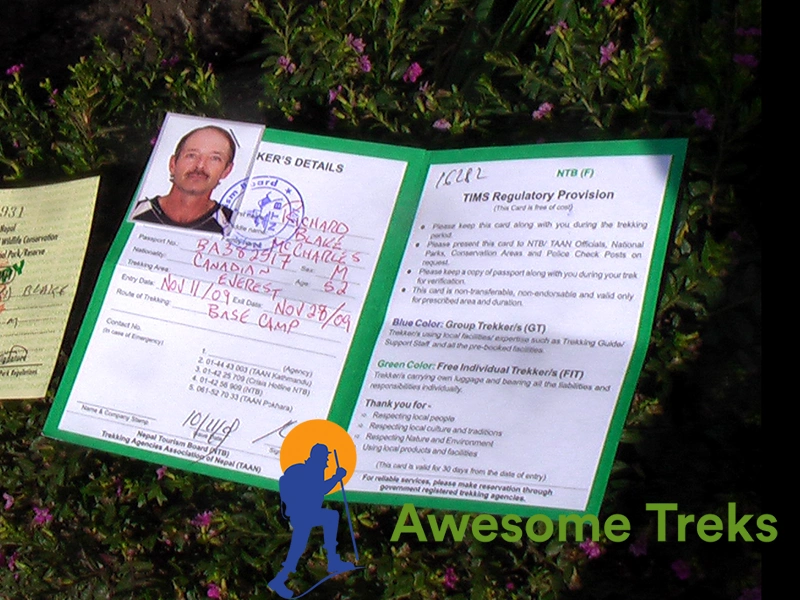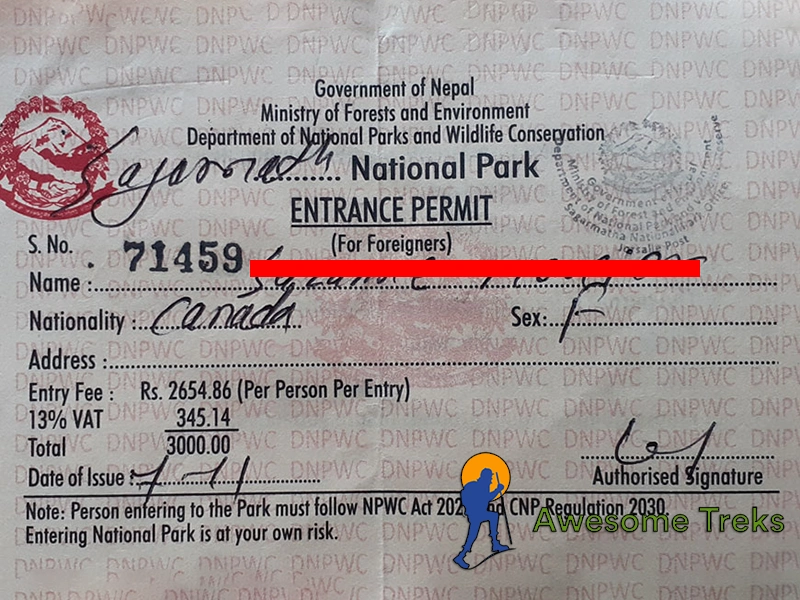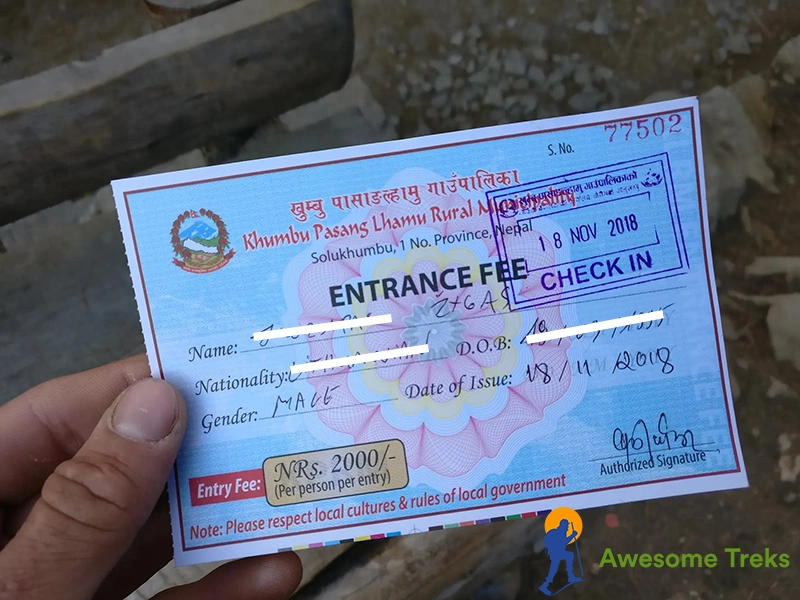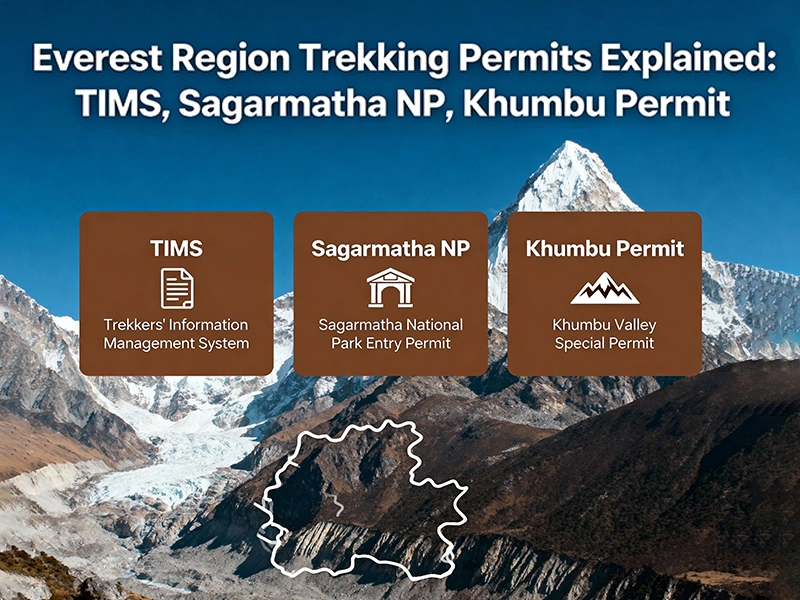The Everest region is a realm of unparalleled beauty, where snow-capped peaks pierce the sky and ancient trails weave through villages steeped in culture. For trekkers aiming to explore this majestic landscape in 2025 or 2026, obtaining the correct permits is not merely a formality – it is a gateway to both safety and sustainable trekking.
Three principal permits govern access to the Everest region: the TIMS (Trekkers’ Information Management System) card, the Sagarmatha National Park entry permit, and the Khumbu Pasang Lhamu Rural Municipality permit. Each plays a unique role: TIMS ensures trekkers’ safety through a national registry, the Sagarmatha NP permit sustains conservation efforts in this iconic park, and the Khumbu permit supports the local communities that welcome travelers into their high-altitude world.
While the permit process can initially seem intricate, with different rules for independent versus guided trekkers, fluctuating fees based on nationality, and checkpoints throughout the region, it is manageable with the right guidance. This comprehensive guide will illuminate every facet of Everest trekking permits, from acquisition procedures and up-to-date fees to indispensable practical tips, ensuring that your Himalayan venture is seamless and fully compliant. With preparation and insight, the grandeur of Everest awaits without bureaucratic hindrance.
TIMS (Trekkers’ Information Management System) Card

For anyone venturing into the Everest region, the TIMS card is the cornerstone of trekking compliance and safety. Established as a national registry, TIMS meticulously tracks trekkers throughout Nepal’s trekking circuits, ensuring that authorities can respond swiftly in case of emergencies. Far from a mere bureaucratic formality, it is a measure that safeguards lives while supporting Nepal’s tourism infrastructure.
Who Needs a TIMS Card?
TIMS is required for nearly all trekkers entering popular trekking regions, including Everest. In recent updates for 2025 and beyond, independent trekkers are encouraged to secure TIMS through a licensed guide or trekking agency, particularly on routes that traverse protected areas. Foreigners, SAARC nationals, and Nepali citizens have separate categories and requirements, making it essential to understand which applies to you.
Cost of TIMS
The TIMS fee varies by nationality:
- Foreign trekkers: approximately NPR 2,000-3,000
- SAARC nationals: lower fees, usually around NPR 1,000-1,500
- Nepali citizens: nominal fee or exempt, depending on the trekking region
How to Obtain TIMS
TIMS can be procured in Kathmandu at NTB counters or through registered trekking agencies, which often streamline the process for trekkers. For those entering the trail via Lukla or other entry points, TIMS must be presented at checkpoints along the route. Applicants typically need a passport, Nepal visa, and a passport-sized photo.
With TIMS in hand, trekkers gain not only a legal safeguard but also the peace of mind to navigate Everest’s trails with assurance, knowing that Nepal’s authorities are aware of their presence and prepared to assist if necessary.
Sagarmatha National Park Entry Permit

Stepping into the Sagarmatha National Park is like entering a sanctuary where Himalayan giants reign supreme and glacial rivers carve valleys of awe-inspiring beauty. To preserve this fragile ecosystem and regulate the flow of trekkers, an official park entry permit is mandatory. This permit is a vital instrument that ensures both conservation and the safety of those exploring the Everest region.
Purpose of the Permit
The Sagarmatha National Park permit serves multiple purposes:
- Conservation: Funds collected contribute directly to protecting the park’s flora, fauna, and delicate high-altitude environment.
- Monitoring: Park authorities use the permit to track the number of visitors, preventing overcrowding and ensuring minimal human impact.
- Safety: Having trekkers registered allows for quicker assistance in emergencies or natural events such as avalanches or landslides.
Fees for Trekkers
The permit fee varies by nationality:
- Foreign trekkers: Approximately NPR 3,000 (USD 25-30)
- SAARC nationals: Around NPR 1,500
- Nepali citizens: Nominal or waived
How to Obtain the Permit
The Sagarmatha NP permit can be acquired at:
- Kathmandu: NTB or DNPWC counters before starting the trek
- Trail entry points: Monjo checkpost, which is the main gateway for the park
Documents required: Passport, visa, and often a passport-sized photo. Many trekking agencies can arrange the permit on your behalf, streamlining the process and saving time.
With this permit, trekkers not only comply with regulations but also contribute meaningfully to the preservation of one of the planet’s most spectacular natural landscapes. It transforms a simple trek into a conscious engagement with the environment and the communities that depend on its sustainability.
Khumbu Pasang Lhamu Rural Municipality Permit

Beyond the national park boundaries lies the Khumbu Pasang Lhamu Rural Municipality, the administrative heart of the Everest region’s local communities. To trek through this area, visitors must obtain the Khumbu permit, a document that directly supports the region’s villages and infrastructure, ensuring that tourism benefits those who call these high-altitude landscapes home.
Purpose of the Permit
The Khumbu permit serves several essential functions:
- Community Support: Fees collected are reinvested into local development projects, health services, and education, enriching the lives of residents along the trekking route.
- Trail Monitoring: The permit helps local authorities track visitor flow, enhancing safety and maintaining the quality of trekking trails.
- Regulation: It ensures that trekking activity aligns with community and environmental standards, protecting the delicate Himalayan ecosystem.
Fees and Collection Points
- Foreign trekkers: NPR 2,000-3,000, depending on the year and point of issuance.
- SAARC nationals and Nepali citizens: Lower fees or exemptions may apply.
- Where to purchase: Lukla, Monjo, or local municipality offices along the trail.
How to Obtain the Permit
Trekkers must present a passport, visa, and passport-sized photo at the checkpoint. Many travelers opt to have their trekking agency secure the permit in advance, which can save time and avoid last-minute complications.
The Khumbu permit is more than a piece of paper, it is a gesture of respect and support for the communities that sustain the Everest trekking experience. By acquiring it, trekkers contribute to the continuity of responsible tourism while ensuring their journey through the region remains smooth and compliant.
How to Get Your Permits
Navigating the permit process for the Everest region may initially seem daunting, but with clarity and preparation, it becomes a straightforward step on your journey. Knowing where to apply, what documents to prepare, and the best approach to obtain each permit ensures a seamless experience and allows trekkers to focus fully on the majestic landscapes that await.
Where to Apply and Collect Permits
- Kathmandu: The capital houses official counters managed by the Nepal Tourism Board (NTB) and the Department of National Parks and Wildlife Conservation (DNPWC). Trekkers can obtain TIMS, Sagarmatha NP, and, in some cases, Khumbu permits here. Licensed trekking agencies often streamline this process, securing all permits on your behalf.
- Trail Entry Points: For trekkers entering via Lukla or passing Monjo, permits can also be issued or verified at checkpoints. This is particularly helpful for those arranging permits through agencies closer to departure.
Required Documents and Preparation
To secure all necessary permits, ensure the following are ready:
- Passport and valid Nepal visa
- Passport-sized photographs (commonly 2-4)
- Completed application forms (either through an agency or directly at NTB/DNPWC)
- Payment in local currency (most counters accept NPR cash; cards may not be universally accepted)
- Trekking itinerary or agency details if traveling with a guide
Practical Tips
- Apply before the trek in Kathmandu to avoid delays or long lines at entry points.
- Use a licensed trekking agency if you prefer convenience, they can secure TIMS, national park, and local permits together.
- Carry copies of all permits; checkpoints and lodges often request verification.
- Keep small cash denominations for fees at trail entry points, as ATMs are limited in the region.
By approaching the process methodically, trekkers ensure a smooth start to their Everest adventure, allowing them to fully immerse themselves in the Himalayan splendor without administrative distractions.
Practical Information for Trekkers
Even with permits in hand, understanding the finer details of Everest region trekking ensures your journey remains smooth, safe, and fully compliant. From updated rules to common questions and insider tips, this guidance helps you navigate the administrative and practical aspects of your trek with confidence.
Updated Rules and Guide Requirement
In recent policy updates for 2025 and beyond, many trekking routes, especially those traversing protected areas, require trekkers to be accompanied by a licensed guide or registered through an approved trekking agency. This ensures:
- Proper safety oversight on challenging trails
- Compliance with TIMS and local regulations
- Enhanced support in case of emergencies or natural events
Independent trekkers should confirm requirements in advance, as rules can vary depending on nationality, season, and the specific trail chosen.
Common Questions from Trekkers
- Do I need all three permits? Yes, for the Everest region, TIMS, Sagarmatha NP, and Khumbu permits are all required.
- Can I buy permits online? TIMS can sometimes be pre-arranged via registered agencies, but park and local permits are generally issued in Kathmandu or at trail entry points.
- What happens if I forget a permit? You may be denied entry to protected areas and fined. Always carry originals and copies.
- Do children need permits? Yes, children trekking the region must have permits, though fees may be reduced or waived.
- Are permits refundable or transferable? Generally, no. They are non-transferable and non-refundable.
Tips for a Smooth Permit Process
- Arrange permits in Kathmandu whenever possible to avoid trail delays.
- Use trekking agencies to consolidate TIMS, national park, and local permits efficiently.
- Carry extra copies of all permits for checkpoints and lodges.
- Keep sufficient cash for remote areas where card payments are not accepted.
By paying attention to these details, trekkers safeguard their adventure while honoring local regulations, ensuring that every step taken amidst the towering peaks of Everest is responsible, informed, and memorable.
Conclusion
Securing the correct permits is far more than a procedural necessity – it is a pledge to trek responsibly, safeguard Nepal’s fragile Himalayan environment, and support the communities that sustain the Everest region. The TIMS card, the Sagarmatha National Park entry permit, and the Khumbu Pasang Lhamu Rural Municipality permit each play a distinct yet complementary role: ensuring your safety, conserving one of the world’s most iconic landscapes, and empowering the villages along the trails.
By understanding the requirements, preparing documents in advance, and adhering to updated regulations for 2025 and 2026, trekkers can navigate the administrative side of their journey with confidence. Whether you choose to arrange permits independently or through a licensed trekking agency, attention to detail and proper planning transforms what could be a bureaucratic challenge into a seamless part of your Himalayan experience.
Ultimately, these permits allow you to step onto the trails of Everest with assurance, knowing that every step is compliant, respectful, and impactful. They unlock not only access to breathtaking vistas and high-altitude adventures but also a deeper connection to the communities and ecosystems that make the Everest region extraordinary. With your permits secured, the path to towering peaks, serene valleys, and unforgettable Himalayan vistas awaits – ready for a journey defined by preparation, responsibility, and awe.
FAQ: Everest Region Trekking Permits
1. What is a TIMS card, and why is it required?
The TIMS (Trekkers’ Information Management System) card is a national registry for trekkers in Nepal. It ensures safety by tracking your presence on trails and helps authorities respond in emergencies. It’s mandatory for most trekking regions, including Everest.
2. Who needs a TIMS card?
Foreign trekkers, SAARC nationals, and Nepali citizens trekking in Everest and other regulated regions must have a TIMS card. Recent rules often require independent trekkers to obtain it through a licensed guide or trekking agency.
3. How much does a TIMS card cost?
Fees vary: NPR 2,000-3,000 for foreigners, NPR 1,000-1,500 for SAARC nationals, and nominal or waived fees for Nepali citizens. Fees may change, so confirm before trekking.
4. What is the Sagarmatha National Park permit?
This permit grants access to Sagarmatha National Park, helping conserve wildlife, monitor visitor numbers, and maintain safety in this high-altitude region.
5. How much is the Sagarmatha NP permit?
Foreign trekkers: NPR 3,000; SAARC nationals: NPR 1,500; Nepali citizens: minimal or waived. Fees are subject to updates by NTB/DNPWC.
6. Where can I get the Sagarmatha NP permit?
Permits can be obtained in Kathmandu at NTB/DNPWC counters or at Monjo checkpost along the trail. Agencies can also arrange permits for trekkers.
7. What is the Khumbu Pasang Lhamu Rural Municipality permit?
It is a local-area permit required for trekking within the Khumbu region. Fees support community development, infrastructure, and trail maintenance.
8. How much is the Khumbu permit?
For foreign trekkers, fees range from NPR 2,000-3,000. Fees for SAARC nationals or Nepali citizens are lower or may be exempt.
9. Where can I obtain the Khumbu permit?
Permits are available at Lukla, Monjo, and local municipality offices. Trekking agencies can often secure them in advance.
10. Do children need trekking permits?
Yes, children trekking the Everest region require TIMS, Sagarmatha NP, and Khumbu permits. Fee reductions or exemptions may apply depending on age.
11. Can I get all permits online?
TIMS can sometimes be pre-arranged via licensed agencies, but Sagarmatha NP and Khumbu permits are generally issued in Kathmandu or at trail entry points.
12. What documents are required for permits?
Passport, Nepal visa, passport-sized photos, completed application forms, and sometimes trekking itinerary or agency details.
13. Are permits transferable or refundable?
No, permits are non-transferable and non-refundable. Each permit is issued specifically for the individual trekker.
14. Can independent trekkers get permits without a guide?
Some areas now require a licensed guide or agency for TIMS and protected-region trekking. Independent trekkers should check regulations for their specific route.
15. When is the best time to get permits?
Arrange permits in Kathmandu before the trek to avoid delays at checkpoints. Agencies can streamline this process efficiently.
16. What happens if I forget a permit on the trail?
You may be denied entry to protected areas or fined. Always carry originals and copies for checkpoints.
17. How long are permits valid?
Permits are valid for the duration of your trek. Ensure your itinerary matches the permit dates to avoid complications.
18. Can trekking agencies help with permits?
Yes, agencies can secure TIMS, Sagarmatha NP, and Khumbu permits on your behalf, saving time and ensuring compliance with regulations.
19. Are fees accepted in foreign currency?
Most checkpoints and offices prefer Nepalese Rupees (NPR). Cash is recommended, as cards are not widely accepted in remote areas.
20. Why are permits important besides legal requirements?
Permits ensure your safety, help conserve the environment, support local communities, and contribute to sustainable trekking practices, enriching your experience in the Everest region.
